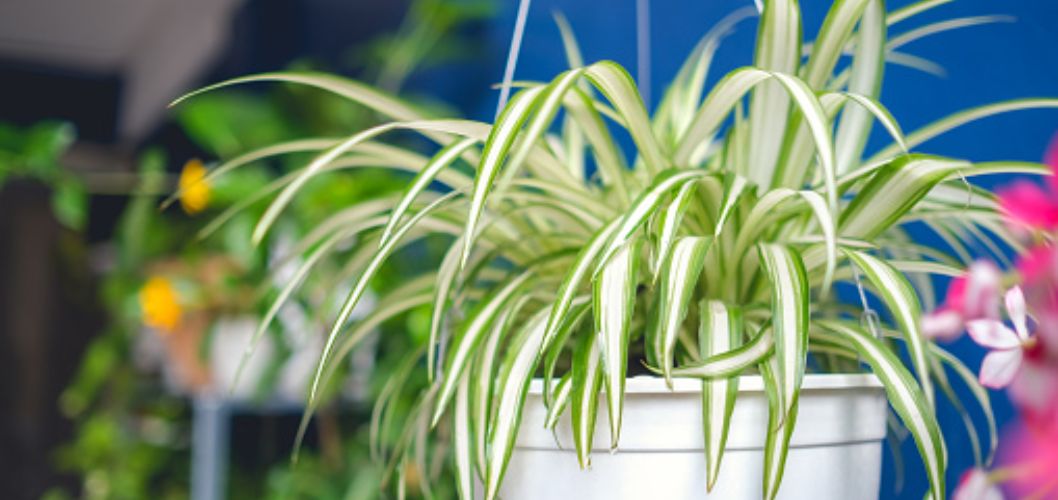Spider plants, also known as Chlorophytum comosum, are popular houseplants due to their lacy, slender foliage and ease of care. These hardy plants can grow well in a range of indoor conditions, making them a great choice for beginners. In this article, we’ll discuss how to care for spider plants.
How to care for spider plants
Light Requirements
Spider plants require bright, indirect sunlight to thrive. Place your spider plant near a window where it can receive at least several hours of filtered sunlight each day. However, too much direct sunlight can cause the leaves to become scorched, so it’s important to avoid placing your plant in direct sunlight.
Watering
Spider plants prefer to be kept consistently moist, but not waterlogged. Allow the top inch of soil to dry out before watering. When watering, water thoroughly until water drains out the bottom of the pot. Be sure to empty any excess water that has collected in the saucer, as spider plants do not like to sit in standing water.
Humidity
Spider plants prefer a higher humidity level, but they can adapt to lower humidity levels as well. If the air in your home is dry, you can increase the humidity by placing a humidifier nearby, or by placing a tray of water near the plant.
Temperature
Spider plants prefer temperatures between 60 and 75 degrees Fahrenheit. Avoid placing your plant in cold drafts or near air conditioning vents, as this can cause the leaves to turn brown at the tips.
Fertilization
Spider plants do not typically require fertilization, but you can fertilize them during the growing season (spring and summer) with a balanced, water-soluble fertilizer. Be sure to follow the package instructions for the correct amount and frequency of application.
Propagation
Spider plants are easy to propagate by dividing the plant’s root ball. Simply remove the plant from its pot and gently separate the individual plants. Re-pot each new plant in a separate pot and water thoroughly.
Pruning
Spider plants may produce small, white flowers on long stalks, which can be removed if desired. You can also prune your plant to keep it looking neat and tidy. Simply remove any yellow or brown leaves, or trim any stems that have grown too long or are taking up too much space.

How to propagate spider plants
Propagating a spider plant is a simple and easy process that can help you create new plants to grow or gift to friends and family. Spider plants can be propagated in two main ways: by dividing the plant or by growing plantlets. Here’s a step-by-step guide on how to propagate a spider plant:
- Choose a healthy parent plant: Select a spider plant that is healthy and has been well-cared for. The plant should have several stems and a good root system.
- Divide the plant: Remove the parent plant from its pot and gently separate the stems and root ball. You can use your hands or a sharp, clean knife to do this. Each stem should have its own set of roots.
- Repot each new plant: After you’ve separated the stems, re-pot each new plant in a separate pot. Use potting soil that is well-draining and rich in nutrients. Water each new plant thoroughly.
- Care for the new plants: Once you’ve divided and repotted the new plants, care for them as you would any other spider plant. Keep them in bright, indirect light and water when the top inch of soil is dry.
- Propagate plantlets: Spider plants also produce plantlets, which are small offshoots that grow from the mother plant. These plantlets can be propagated by cutting them from the stem and planting them in soil. Wait until the plantlets have several roots and are at least a few inches tall before cutting them from the mother plant.
- Grow in water: Another option for propagating spider plants is to grow the cuttings in water. Simply cut off a stem with several leaves and place it in a container filled with water. Change the water every few days and watch as roots begin to grow. Once the roots are several inches long, you can plant the cutting in soil.
Conclusion
In conclusion, spider plants are beautiful, low maintenance houseplants that can thrive in a variety of indoor conditions. By following these simple care tips, you can enjoy your spider plant for years to come.

